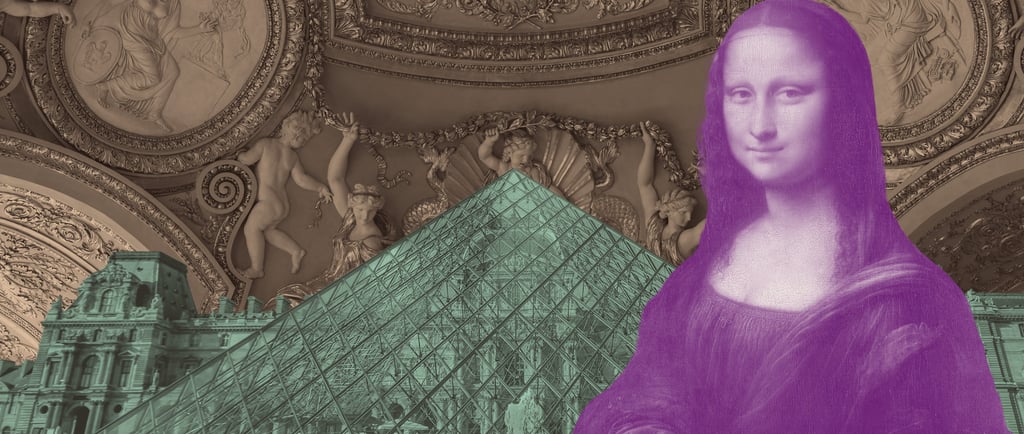Discover the Louvre: 15 Fascinating Facts About the World’s Most Iconic Museum
Discover 15 fascinating facts about the Louvre—from its medieval fortress roots to the iconic glass pyramid. Explore its rich history and plan your unforgettable visit today!
Karolina K.
5/28/20253 min read


1. From Fortress to Palace: The Louvre’s Medieval Roots
The Louvre wasn’t always a museum. It began in 1190 as a fortress built by King Philippe Auguste to defend Paris’s vulnerable western side against invasions. The original medieval structure included a massive keep surrounded by a dry moat—far from the art palace we know today.
2. The Grande Vis: An Architectural Marvel
One of the Louvre’s standout features was the great spiral staircase, known as the grande vis. Built as a grand entrance to the sovereign’s private quarters, it was celebrated for its impressive size, elegant proportions, and detailed ornamentation—a symbol of the palace’s prestige.
3. Charles V and the Power of Portraiture
Charles V used the Louvre to project royal power. His portrait statues adorned the exterior and the staircase, accompanied by statues of his royal family across three generations. This arrangement underscored the Louvre’s identity as a monument to the Valois dynasty and emphasized genealogical continuity.
4. A Royal Residence Turned Public Museum
Before becoming a museum open to all, the Louvre was the home of French kings for centuries. From the Middle Ages until the Second Empire, it served as the Parisian royal residence and housed prestigious academies of art and architecture.
5. The Louvre Opens to the Public in 1793
Amid the French Revolution, the Louvre transformed into a public institution. Officially opened in 1793, it was envisioned as a “civic lesson” through art—a place where the treasures of the Crown became accessible to all citizens, reflecting Enlightenment ideals of knowledge and education.
6. The Name “Louvre”: Wolves or Oak Woods?
The origin of the name “Louvre” is debated. Some scholars link it to the Latin lupus (wolf), suggesting it referred to a place where wolf hunting parties were kept. Others propose a connection to roboretum, meaning an oak wood, hinting at the landscape that once surrounded it.
7. The Grand Dessein: Uniting Palaces
King Henri IV dreamed of uniting the Louvre with the nearby Tuileries Palace via the Grande Galerie, creating an enormous multifunctional complex. This ambitious project was partially completed and shaped much of the Louvre’s current layout.
8. Napoleon’s Vision: Musée Napoléon
Under Napoleon I, the Louvre was renamed Musée Napoléon in 1803. His goal was to make Paris “the rendezvous of all Europe.” During this time, the museum’s collections expanded dramatically through acquisitions and spoils from military campaigns.
9. The Iconic Glass Pyramid: A Modern Entrance
In the 1980s, architect I.M. Pei designed the now-famous glass pyramid, serving as a single, underground entrance. This modern addition both respects the Louvre’s historic architecture and efficiently accommodates millions of visitors annually.
10. The Louvre: The Most Visited Museum in the World
In 2018 alone, the Louvre welcomed over 10 million visitors, making it the world’s most visited museum. It remains a cultural beacon, housing masterpieces spanning thousands of years and multiple continents.
11. Hidden Treasures: Coronation Artifacts
Surprisingly, some French royal coronation instruments survived the Revolution and are now exhibited in the Louvre’s Decorative Arts collection. This includes the legendary sword "Joyeuse," believed to have belonged to Charlemagne.
12. A UNESCO World Heritage Site
The Louvre, along with its surroundings like the Arc de Triomphe du Carrousel and Jardin des Tuileries, is part of the UNESCO World Heritage site "Paris, banks of the Seine" — highlighting its cultural and historical significance.
13. Baudelaire’s Critique: Beyond the Famous Works
Writer Charles Baudelaire saw the Louvre as a space between private art salons and public city life. He critiqued visitors who focused only on famous works, urging appreciation for the museum’s lesser-known pieces and transient beauty.
14. The Louvre’s Medieval Collections
The medieval art collection is unique in that it is organized by type rather than chronology. Initially acquired by chance during the Revolution, these collections gained importance in the 19th century, thanks to dedicated curators and supporters.
15. The Lost Tuileries Palace
Connected historically to the Louvre, the Tuileries Palace was destroyed during the Paris Commune in 1871. Today, there’s a committee advocating for its reconstruction to restore the original perspective and add more space for the museum.
Final Thoughts
The Louvre is not just the world's most famous art museum—it is a living monument to centuries of French history, architecture, and culture. Whether you’re captivated by the royal statues of Charles V or eager to explore the latest exhibitions, the Louvre offers endless discoveries.
Next time you visit, remember that behind the glass pyramid lies a treasure trove of stories, from medieval fortresses to revolutionary ideals, all waiting to be uncovered.
Keywords: Louvre, Louvre Museum, Paris, history, palace, Louvre Glass pyramid, art, Charles V, grand vis staircase, Napoleon, Tuileries, UNESCO
Contact
Contact us via email:
Subscribe to our newsletter!
office@tellmemoretravel.com
© 2025. All rights reserved.
